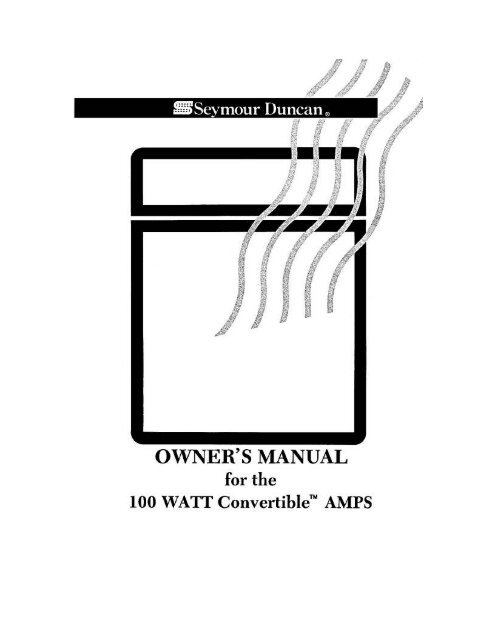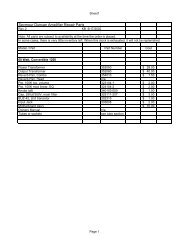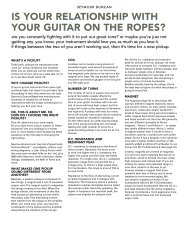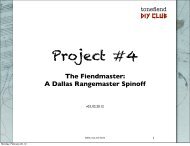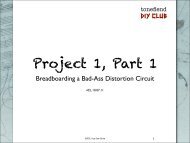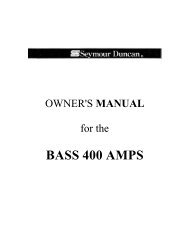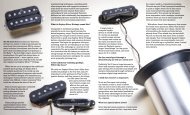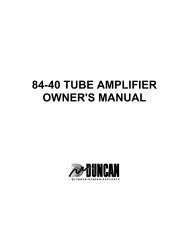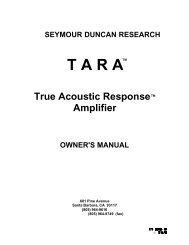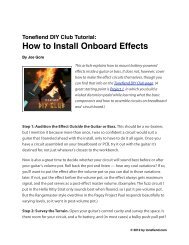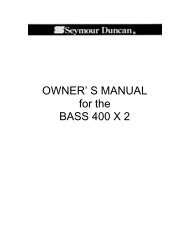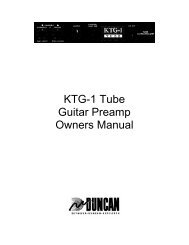100 Watt Convertible™ Amp - Seymour Duncan
100 Watt Convertible™ Amp - Seymour Duncan
100 Watt Convertible™ Amp - Seymour Duncan
Create successful ePaper yourself
Turn your PDF publications into a flip-book with our unique Google optimized e-Paper software.
If you're like most musicians I know, the first thing you want to do is plug-in your new<br />
amp and start playing - the last thing you want to do is read an owner's manual. Go<br />
ahead and play the amp and see what it can do for you.<br />
Once you've completed the "breaking in" experience, please read through this manual.<br />
The Convertible" amp was designed to give you any sound that's in your head. To<br />
provide that versatility, many unique and exclusive features are built-in. This manual will<br />
show you the easy way of getting a wide variety of great sounds just by properly setting<br />
up the amp.<br />
Enjoy it. If you have any comments about the design of your amp, I'd like to hear from<br />
you. If you have any ideas for modules or other related products, please write me at the<br />
address below.<br />
Thank you,<br />
P.S. If you haven't mailed in your warranty card, please do it now. It may seem like a<br />
hassle, but it's the only way we have to verify warranty status of your amp.
Unpacking<br />
Inspect your ConvertibleTM amp for hidden damage that may have occurred in transit.<br />
Your amp was inspected and sound tested before shipment from the factory.<br />
All claims for shipping damage must be made by the receiver. Save your box and<br />
packing material for evidence of damage if it has occurred.<br />
Packing Materials<br />
The original box and packing materials are specially designed to protect your amp during<br />
shipment. SAVE ALL PACKING MATERIALS. In the unlikely event that your amp<br />
needs to be returned to the factory, the original box and packing material will be<br />
necessary for shipment. These are carrier approved packing materials and they will<br />
insure safe transit back to the factory.<br />
Specifications for <strong>100</strong> watt Convertible <strong>Amp</strong>s<br />
Combo<br />
Head<br />
Weight: 57 lbs 42 lbs<br />
Cabinet Dimensions: 19 3/4" h 10 15/16" h<br />
18 25/32" w 21 25/32" w<br />
11 3/8" d 11 1/16" d<br />
Power Requirements: 120 volts a.c. (U.S. models)<br />
Power Consumption: 480 watts at full rated output.<br />
Power Circuit:<br />
All tube, EL-34 tubes <strong>100</strong> watt rms<br />
@ 8 ohms from 8 ohm output @<br />
120 v.a.c. @ 5% @ 1 khz.<br />
Damping Factor:<br />
From damping output: - Low 0.1<br />
into 4 ohms', - High 4.0 into 8<br />
ohms<br />
Input Impedance:<br />
4.7 meg-ohms adjustable to zero<br />
via load resistor plugs.<br />
Input Sensitivity: (With Normal, Normal,<br />
Normal modules): 1.2 millivolts.<br />
Dynamic Headroom: 4-5 db
Table of Contents<br />
Front Panel Controls……………………………………………………………………Page 4-5<br />
Rear Panel Controls..……………………………………………………………….....Page 6-7<br />
Module Arrangements………………………………………………………….………Page 8-9<br />
Preamp Modules………………………………………………………………….…Page 10-11<br />
Changing Modules……………………………………………………………………....Page 12<br />
Tubes Preamp………………………………………………………………….…..……Page 13<br />
Power………..……………………………………………………………………………Page 14<br />
Load Resistor Plugs……………………………………………………………………..Page 15<br />
Trouble Shooting…………………………………………………………………….Page 16-18<br />
Blank Module Arrangements……………………………………………………….Page 19-20
1) LOAD RESISTOR INPUT (Combo only) Guitar pickups have different output<br />
voltages. Using the load resistor plugs supplied with your combo amp, you can match<br />
your pickups to the amp's input.<br />
STANDARD ELECTROMAGNETIC PICKUPS<br />
Convertible amps have 4.7 meg-ohm input jacks. Some players prefer using no load<br />
resistor plug because they want the brightest sound possible and 4.7 is a good match<br />
with their pickups. You should experiment with the two load plugs provided to find your<br />
favorite setup.<br />
It is recommended that the input impedance of the amp be 10 to 20 times higher than<br />
the pick-up output impedance to avoid excessive "loading".<br />
UNIOUE DESIGN PICKUPS<br />
LOW IMPEDANCE PICKUPS: To optimize signal to noise ratio, input impedance should<br />
be fairly low - typically <strong>100</strong> to 10k ohms. Try the lOk330pf load resistor plug for great<br />
tone and low noise.<br />
PIEZO TRANDUCERS (built in to acoustic guitars): To avoid loading down Piezo<br />
pickups, the input impedance should be high. Most players like the sound with these<br />
pickups using no load resistor plug.<br />
ELECTROMAGNETIC ACOUSTIC GUITAR PICKUP: To get a warm, round sound,<br />
many players like using the 1 meg load resistor plug, It gives a smooth high end and<br />
quiets the signal.<br />
2) MAIN GUITAR INPUT: When using only one instrument, this is the only jack that is<br />
live.
3) AUXILIARY GUITAR INPUT: Use this input for a second guitar or other instrument.<br />
This is a parallel input to the Main Guitar Input so they will both play through the "on"<br />
channel.<br />
If you use the Auxiliary Input for a second instrument, the output volume from both<br />
instruments will be reduced. You will have to increase the Master Volume control to<br />
compensate. Also, the instrument that is plugged into the Auxiliary Input will have less<br />
volume than the instrument plugged into the Main Input. If you need both instruments<br />
playing at their loudest volume, you can plug them into a "Y" cord and run them both<br />
through the Main Guitar Input.<br />
If you want to use one guitar playing through two amps, plug your guitar into the Main<br />
Guitar Input and run a normal guitar cable from the Convertible's Auxiliary Guitar Input to<br />
the main input on your second amp.<br />
4) OVERDRIVE: This control dictates the amount of preamp distortion and influences<br />
the volume you want to add to your signal. The lowest setting gives the cleanest signal<br />
and lowest volume. The highest setting gives the most distortion and highest volume.<br />
Technically it controls the gain level applied from Stage 2 to Stage 3 of the preamp,<br />
Although the intensity of overdrive varies with the modules YOU use, the relative effect<br />
is the same: clockwise increases distortion: counterclockwise decreases distortion.<br />
Like all of the preamp controls on this amp, each channel is independent. You can have<br />
a clean setting on one channel and a distorted setting on the other channel.<br />
5) MASTER VOLUME: This control sends the signal volume from the preamp to the<br />
power amplifier. For the cleanest signal, turn the Master Volume up high and keep the<br />
Overdrive low (but not off). For the dirtiest signal turn the Master Volume down (but not<br />
off) and the Overdrive up high.<br />
6) CHANNEL 1 INDICATOR (Red): When your amp is in Channel 1 and the power is<br />
on, this L.E.D. will glow. It's indicating that only the controls on this row will affect your<br />
sound.<br />
7) CHANNEL 2 INDICATOR (Green): When your amp is in Channel 2 and the power is<br />
on, this L.E.D. will glow. It's indicating that only the controls on this row will affect your<br />
sound.<br />
Your Convertible amp uses L.E.D.'s instead of bulbs because L.E.D.'s will last up to 10<br />
times longer than regular bulbs. Under normal usage, your L.E.D.'s should last 10 years.<br />
8) TONE CONTROLS: The two sets of tone controls allow you to get the tone coloration<br />
you want from each channel without affecting the tone of the other channel. The three<br />
tone controls - treble, mid, bass - are a standard interdependent circuit. As you increase<br />
the mid control, the treble and bass will yield less range.<br />
Experiment with these controls to find where they work best with your guitar and the<br />
room you're playing in.<br />
Note: If you turn all tone controls "Off" (farthest to the left), no sound will come out of<br />
your amp.
When you re using "Low-Cut" modules the bass controls will have less effect on your<br />
sound because the module s rolling off much of the bass response. The 'Presence'<br />
module will be greatly affected by the treble control (See pages 10-11 Preamp Modules<br />
for other tone you can get with different modules)<br />
TREBLE TONE CONTROLS: These controls you change the high-end response of your<br />
amp Each is a high-pass passive that can reduce the signal level 0-38 db with a 6 db per<br />
octave slope Turning the dial clockwise increases high-end response: counter reduces<br />
the high-end response<br />
MID TONE CONTROLS: These controls let you change the volume of mid-range within<br />
a range of 0-12 db. Turning the dial increases your midrange volume.<br />
BASS TONE CONTROLS: These controls let you change the low-end response of your<br />
amp. Each is a low-pass passive filter that can reduce the signal level 0-15 db. Turning<br />
the dial clockwise increases the low-end response.<br />
9) REVERB: These controls let you set the amount of reverberation you want in your<br />
sound. Turn the reverb control clockwise to increase the amount of reverb and<br />
counter-clockwise to decrease.<br />
Some players prefer no reverb or one channel only. Can you imagine changing channels<br />
with a footswitch and using another switch to turn the reverb on and off? With the two<br />
independent reverb controls, you can see as much reverb, as you like on one channel<br />
and turn the other channel's reverb “off'” by simply turning the control counter clockwise<br />
That way you can concentrate on your playing and avoid the footswitch distraction.<br />
10) CHANNEL SELECTOR BUTTON: This pushbutton lets you change channels<br />
manually The L.E.D 's show you which channel is 'on' If you prefer to use a footswitch,
use the channel selector button to put the amp in the green L.E.D channel first, then the<br />
footswitch will operate<br />
11) CHANNEL SELECTOR JACK: This jack accepts a standard '4 guitar cord (not<br />
supplied) for connection to the footswitch. When hooked up, the footswitch allows you to<br />
change channels arid take advantage of the independent volume, overdrive, tone, and<br />
reverb controls<br />
The <strong>Seymour</strong> <strong>Duncan</strong> footswitch L.E D will glow only when you're playing through the<br />
top channel.<br />
Some amps produce a loud 'pop" through their speakers when channel switching The<br />
Convertible amp uses a channel switching circuit built into the preamp that is isolated<br />
from other electronics No annoying pops will occur when changing channels<br />
12) VARIABLE POWER CONTROL: This control changes the power amplifier current to<br />
reduce or increase power amplifier wattage <strong>100</strong> watt tube amps are great for playing in<br />
large clubs where you need lots of power, but for smaller places, a low powered amp<br />
might be more useful To get amplifier distortion you need to work the power amp section<br />
hard - pushing it beyond its limits With the Convertible amp, you dial in the amount of<br />
power you need from <strong>100</strong> watts down to 5 watts<br />
For the cleanest signal, use all <strong>100</strong> watts and turn the Master Volume control to adjust<br />
loudness. For a distorted sound, turn the Master Volume control pas! 1 o'clock and use<br />
less power. You will get a warm, round distortion that is heard only on small amplifiers<br />
Variable Power is not like typical preamp overdrives. The. Variable Power circuit actually<br />
controls the cutout stage of the amp. When the Master Volume control is set low you will<br />
notice little or no change from the Variable Power control because you are asking the<br />
amp to give you very, little wattage. The higher you set the Master Volume control, the<br />
more you will notice the effect of Variable Power. Experiment to find where you like it<br />
best,<br />
Note: The full Power range (5 to <strong>100</strong> watts) is available when running the amp in the<br />
Pentode mode (See page 7 for Pentode/Triode switch). Variable Power will control 3 to<br />
60 watts in the Triode mode.<br />
13) VARIABLE POWER JACK: Use this lack with a PASSIVE volume pedal (<strong>100</strong>-500k<br />
ohm range) to remotely change Variable Power. CAUTION: An active volume pedal (the<br />
type that uses batteries or a c. power) will not work in the circuit.<br />
When you turn up the Variable Power, you not only get the most power available, but<br />
also less distortion from the amp. If you want to change Variable Power while you're<br />
playing, a volume pedal lets you do it easily. Many players like to use all <strong>100</strong> watts while<br />
playing clean rhythm and then use the Variable Power with a volume pedal to reduce the<br />
power and get amplifier distortion for lead work<br />
Variable Power can also be changed with a footswitch. When the footswitch is "off", you<br />
will get all <strong>100</strong> watts. When the footswitch is "on", you will get only 5 watts. When using<br />
the footswitch, the Variable Power Control knob will have no effect. Your only choices<br />
are <strong>100</strong> watts or 5 watts.
1) FUSE HOLDER: The fuse is located in the cap of the fuse holder. If the fuse fails, it<br />
must be replaced with one that provides proper current protection or you will void the<br />
warranty. The proper fuse rating for the 110-120 v.a.c. Convertible amp is 5A 250V slo<br />
blow.<br />
Before removing the fuse cap, UNPLUG THE POWER CORD FROM THE WALL A.C.<br />
OUTLET. After checking the fuse and replacing the fuse cap, you can plug the amp back<br />
into the wall.<br />
To remove the fuse cap, simply grasp the cap with your fingers, push in, and turn<br />
counter-clockwise. To replace the cap, grasp the cap with your fingers, push in, and turn<br />
clockwise.<br />
Fuses do not wear out; they do not deteriorate with age. Fuses are protection devices<br />
that prevent the electronics from damage if there is a serious electrical problem. If your<br />
amp repeatedly has fuse failures, check page under "Fuse Failure" for troubleshooting<br />
tips.<br />
2) ON/OFF/ON POWER SWITCH: This switch is designed to turn your amp on and to<br />
allow you reverse the a.c. polarity. If you're picking up 60 hz hum from the wall current,<br />
put the "ON" switch in the other "ON" position. If you're using other equipment like a P.A.<br />
and you get a shock when touching the microphone, place the "ON" switch in the other<br />
"ON" position to eliminate the shock. The middle position is "OFF".<br />
3) STANDBY: Use this switch when you will not use the amp for a short time period (like<br />
in-between sets). This switch turns off the sound output but keeps the tubes warm and<br />
ready to play.<br />
Standby switches are important on tube amps because the tubes wear out quickest from<br />
temperature change. When the amp is off, the tubes will cool, when they're on, they get<br />
hot. Standby keeps them in operation so they stay warm and give you long life. Because<br />
of the high gain circuitry in your amp, it is normal to hear some residual noise through<br />
your speaker for one minute after switching into "Standby".
With the Standby switch in the up position, your amp will be on With the Standby switch<br />
in the down position, Standby will be in operation and no sound will come from the amp.<br />
4) A.C. CONVENIENCE OUTLETS: These outlets let you plug in other equipment for<br />
a.c. power. They can supply a total of 700 watts. To find out how much wattage your<br />
equipment uses, look on the back of the unit where the power cord is located. Most<br />
companies will list the wattage demand there. For example, your Convertible amp uses<br />
480 watts.<br />
NEVER PLUG IN UNITS THAT DRAW MORE THAN A TOTAL OF 700 WATTS, OR<br />
YOU WILL RISK THE POSSIBILITY OF AN ELECTRICAL FIRE.<br />
5) EFFECTS LOOP: Use this circuit with your effects for the least amount of hiss, In<br />
older design amps, players had to plug their guitars directly into effects and plug the<br />
effects into the guitar input jacks on their amps. With the Convertible amp, you can plug<br />
your guitar into the guitar input jack and run your effects through the Effects Loop.<br />
The "Send Level" control lets you match the Effects Loop output to the input of your<br />
effects. When the level is set too low, too much hiss will come through the speaker and<br />
the volume will be low.<br />
When the level is set too high, you will overload the effect input and cause too much<br />
distortion Experiment with the setting to find the best match for your effects<br />
''Effects Send" should be connected to the input of your effect using a normal guitar<br />
cable. "Effects Return" should be connected to the output of your effect using a normal<br />
guitar cable. You want the signal to come OUT of your amp INTO the effect and OUT of<br />
the effect INTO your amp.<br />
6) REVERB: This is where your reverb connects. The return jack accepts the reverb<br />
cable with a red dot on the plug.
Convertible amps are designed with Accutronics 2-spring reverbs. These are the most<br />
natural sounding reverb units available and they provide a wide range of reverb for your<br />
playing styles.<br />
7) PENTODE/TRIODE SWITCH: This switch changes the operation of the EL-34 output<br />
tubes, which use five components inside each tube. With this switch in the up position,<br />
the tubes run in the Pentode mode and all five components operate for full <strong>100</strong>-watt<br />
power. The sound is brighter and crisper.<br />
With the switch in the down position the tubes run in the Triode mode and three<br />
components operate for 60-watt maximum power. The sound is smoother with a little<br />
less edge. Experiment with this switch to find where you like it for your musical style.<br />
Some amps have 60/<strong>100</strong>-watt switches. What they do is turn off the voltage to two<br />
tubes. That causes the power to drop but also places stress and wear on the two tubes<br />
that are on. The Pentode/Triode switch allows all tubes to run stress-free and provides<br />
longer life to all the tubes.<br />
8) VARIABLE DAMPING: This circuit is included with Convertible amps to give you<br />
more control over your sound. Damping is the amount of control the amplifier has on the<br />
speaker. High damping (turning the control to the right) increases the control of the<br />
speaker - the sound is crisper and tighter. Low damping (turning the control to the left)<br />
decreases the control of the speaker - the sound is looser and fatter sounding with<br />
slightly more presence.<br />
There is no recommended setting because only you can tell what's best for the sound<br />
YOU want to produce. This control is effective ONLY when the speaker is connected to<br />
the "Variable Damping Out" speaker jack.<br />
9) 4 OHM, 8 OHM SPEAKER JACKS: You can use these jacks to match the amp<br />
impedance to the input of the speakers you use. Proper connection to these jacks will<br />
give you maximum power and maximum damping.<br />
If you choose to run an 8 ohm speaker in the 4 ohm jack, no damage will result in the<br />
amp or with the speaker, it will just sound different from being played through the 8 ohm<br />
jack. The same situation is possible with a 4 ohm speaker in the 8 ohm jack.<br />
You can also use all three-speaker jacks at the same time with different speakers. The<br />
Convertible amp's strong transformer can handle almost any load with no damage.<br />
10) SLAVE OUT: Use this jack for patching the output signal of the amp directly into a<br />
mixer, tape recorder, or another amp. Just use a regular guitar cord from Slave Out to<br />
the guitar input of the other unit. The circuit is wired after the output stage so all tone,<br />
volume, damping control, effects loop, etc. controls will affect the outgoing signal. Output<br />
is one volt at full power.
MODULE ARRANGEMENTS<br />
Your amp was shipped with the modules arranged in the configuration drawn below.<br />
Remember your guitar signal runs in series through three modules per channel before<br />
reaching the amplifier. The modules for the red channel are in positions #1, 2, and 4.<br />
The modules for the green channel are in positions #1, 3, and 5. In this section you will<br />
find a number of different module arrangements and the sound produced from each. To<br />
replace or rearrange modules, follow the steps under "Changing Modules".<br />
Here is the way modules are arranged when Convertible amps are shipped<br />
Below are just some of the module arrangements you can try for different sounds. Your<br />
dealer has a wide selection of modules for you to choose from that you can use to<br />
customize your sound even more. And each year, new modules will be introduced.
CHANGING MODULES<br />
The five factory installed preamp modules are located directly under the Quick AccessTM<br />
module system plate on the top of the amp. Changing modules is quick and easy.<br />
Dramatic tone changes are possible just by rearranging your present module<br />
configuration. To replace or rearrange the modules, just follow these easy steps.<br />
TO REMOVE:<br />
1. UNPLUG YOUR AMPLIFIER from the power outlet.<br />
2. Turn the Quick Access plate screws counter-clockwise - they<br />
will POP UP<br />
3. Remove the plate.<br />
4. Looking down inside the amplifier, firmly grasp the module you<br />
want to replace by its handle and lift slowly. When the module<br />
is free from its receptacle, continue to lift upward. You may<br />
have to turn the module sideways to clear the module opening.<br />
TO REPLACE: 1. MAKE SURE THE AMPLIFIER IS STILL UNPLUGGED.<br />
2. Choose the module you want to install and grasp by its handle.<br />
3. Insert the module to be installed through the Quick Access<br />
module system opening. It may be necessary to turn the<br />
module sideways before it will fit through the module opening.<br />
4. Align the module plug to be installed over the receptacle in the<br />
module position you have chosen.<br />
5. Slowly insert the module into the receptacle. Apply moderate<br />
pressure until you feel the module is seated snugly.<br />
6. Repeat steps 2 thru 5 for each module you want to replace/<br />
rearrange. When you have finished changing modules, doublecheck<br />
all modules to ensure they are still snug in their receptacles.<br />
7. Align the module system plate with the holes in the top of the<br />
amplifier cabinet and then secure.<br />
8. Make sure that the Volume and Variable Power controls are at<br />
a low setting and Standby switch is place in the ON position.<br />
9. Plug the power cord from the amplifier into the 110-120Vac wall<br />
outlet and place the <strong>Amp</strong> Power switch in the ON position.<br />
10. After a one-minute warm-up, flip Standby switch on the rear<br />
panel to the "ON" position and you're ready to play.
TUBES<br />
Just like all other parts in the Convertible amps, the tubes were selected for providing<br />
the most musical tones. Tubes can be temperamental, but there are things that can be<br />
done to avoid problems.<br />
Module Preamp Tubes The 1 2AX7 Tungsram tubes will give you the least amount of<br />
noise and the sweetest tone. However, they develop a microphonic ringing when<br />
subjected to a lot of bumps from traveling.<br />
Typically, microphonics are most sensitive from the input module (the module that's<br />
shared by both channels). Here are some ways to eliminate microphonics.<br />
1. You can swap the tube from another preamp module with the input module.<br />
2. If you are using two identical modules and one of them is the input module, just<br />
switch the position of the two modules.<br />
For example: Classic<br />
Classic ----- Hi Gain<br />
Normal ----- Presence<br />
Just take the two "Classic" modules and switch their positions. If the second "Classic"<br />
module's tube does not have microphonics you've solved the problem.<br />
3. Polish 1 2AX7 tubes are constructed differently than the Tungsrams. Although<br />
Polish tubes are noisier and harder sounding, they are less subject to<br />
microphonics. Radio Shack and other companies offer Polish tubes. "Made in<br />
Poland" is stamped directly on those tubes so you can be sure where they come<br />
from.<br />
4. Try using an FET or IC module in the input. Because neither of these are tube<br />
designs, you'll get no microphonics. For a warmer tube sound, use an FET<br />
module in the input stage. If you're after a harder solid-state sound, use an IC<br />
module in the input stage.<br />
If you're involved in a touring schedule and you want to avoid tube related problems,<br />
bring some extra tubes with you for all YOUR equipment.
SPARE TUBE<br />
There is a spare 12AU7 tube mounted inside your Convertible amp. This is a stock<br />
replacement tube for the Cascode module.<br />
We also discovered an interesting sound when replacing the standard 12AX7 tube in the<br />
Classic module with a 12AU7 tube. If you use a Classic module in the input stage (first<br />
position), try using the 1 2AU7 tube there. You'll notice a little less output volume, but it<br />
will also allow you to get a louder, clearer rhythm. Try this setup:<br />
Classic with 12AU71 Classic Normal Hi-Gain Presence<br />
If you play a guitar with a high output humbucker pickup and you're having problems with<br />
a loud, clean rhythm, this could easily provide the sound you're after.<br />
POWER AMP TUBES<br />
Convertible amps are designed for use with EL-34 power tubes. These tubes will give<br />
you the sweetest tone and are generally more "musical".<br />
The EL-34 tubes installed in your amp are specially matched for cathode current. This<br />
reduces hum and noice -especially noticeable when playing quiet passages and in the<br />
recording studio. You'll notice a little label attached to the base of each tube that shows<br />
current draw. When you replace your output tubes, make sure to ask for matched sets to<br />
keep your amp sounding like new.<br />
If you're transporting your amp often and subjecting it to rough handling, there are other<br />
power tubes that will better withstand the abuse.<br />
The 6CA7 is an industrial version of the EL-34. While the tone is not as sweet as<br />
EL-34's, it is better suited to handle bumps and bangs. You can plug 6CA7 tubes directly<br />
into the power tube sockets because the pin matchups are identical and the amp bias<br />
will not have to be changed.<br />
The 6L6 and 6550 tubes will also stand up to road knocks. Like the 6CA7 tubes, they are<br />
not as musical as EL34's. You'll notice a harder sound. Although the pin matchups allow<br />
you to directly plug 6L6 and 6550 tubes into the power tube sockets, you'll need to have<br />
a service technician replace a bias resistor with one that's value matches the 6L6's or<br />
6550's. See your authorized service center for cost
LOAD RESISTOR PLUG VALUES AND SOUND EFFECTS<br />
The Front Panel Section, under the paragraph describing the Load Resistor Input,<br />
includes suggestions for altering the amplifier input impedance to match the impedance<br />
of the pickup(s) in your instrument. The information in the chart below and the<br />
instructions that follow have been provided to enable you to further customize your<br />
sound by making your own load plugs using capacitors, resistors, and RCA input plugs<br />
available at most hardware or electronics stores. Various capacitance and resistance<br />
values are given, with a description of their overall effect on your sound.<br />
With each <strong>Seymour</strong> <strong>Duncan</strong> Convertible Combo amp YOU receive the following two (2)<br />
load resistor plugs:<br />
Load Input<br />
Value at 1 kHz<br />
500k<br />
Capacitance<br />
(in picofarads)<br />
3300pf<br />
1 meg -0-<br />
Resistance<br />
(in ohms)<br />
10k<br />
1 meg<br />
Sound Effect<br />
Use with acoustic<br />
pickup to enrich<br />
tone<br />
Will make tone<br />
slightly smoother<br />
sounding<br />
Other plugs that you can build yourself include:<br />
Load Input<br />
Value at 1 kHz<br />
26k<br />
Capacitance<br />
(in picofarads)<br />
.01<br />
Resistance<br />
(in ohms)<br />
10k<br />
11.5 k .1 10k<br />
10k -0- 10k<br />
Sound Effect<br />
Slightly rolled off<br />
high-end. Use in<br />
bright sounding<br />
room or with<br />
pickups that are too<br />
bright<br />
For mellow, smooth<br />
jazz sounds<br />
Quietest operation<br />
when using Low<br />
Impedance pickups<br />
How to make a load resistor plug:<br />
Purchase raw RCA plugs and resistors at an electronics hardware store. Using a single<br />
resistor with a value of 1-ohm - 4.7 meg ohm, 1/8 watt or 1/4 watt, simply solder it to the<br />
hot (pin) and to the ground (crown). You can also try different value capacitors with<br />
physical size being your only limitation. For reference, you may want to examine one of<br />
the supplied load plugs and compare.
TROUBLESHOOTING<br />
The following table should enable you, with little or no knowledge of electronics, to<br />
isolate the cause of some problems you may experience with your amplifier and the<br />
steps required for repair. Most causes of impaired amplifier performance are due to<br />
minor problems or irregularities, which can be easily corrected by you. However, if you<br />
cannot identify the cause of the problem using the table below, or if it indicates your<br />
amplifier to be defective and in need of repair, return the unit to an authorized <strong>Seymour</strong><br />
<strong>Duncan</strong> Service Center or call (805) 964-9610 for a Return Authorization number.<br />
Symptom Probable Cause Remedy<br />
<strong>Amp</strong>lifier does not come on<br />
1) Ensure power cord is<br />
1) Power not connected<br />
when power switch is "ON".<br />
plugged into power outlet<br />
2) Check amp fuse; replace<br />
2) Blown amp fuse if blown with 250VAC 5<strong>Amp</strong><br />
SLO-BLOW<br />
3) No source voltage<br />
3) Verify power source with<br />
something you know works<br />
4) Defective ON/OFF power<br />
switch<br />
4) Return unit to dealer or<br />
factory for repair<br />
No sound coming from<br />
speaker(s), (No audible<br />
amplifier hum).<br />
Loud amplifier hum<br />
1) <strong>Amp</strong>lifier in standby<br />
2) Master Volume and/or<br />
Overdrive control levels set<br />
too low.<br />
3) Speaker output plug<br />
disconnected or output<br />
wires shorted.<br />
4) Instrument<br />
pickup/electronics may be<br />
defective.<br />
5) Defective speaker(s)<br />
61) Volume controls on<br />
your instrument are down<br />
7) Defective center driver<br />
tube 12AX7<br />
8) Defective 5U4GB<br />
rectifier power tube<br />
1) Place standby switch in<br />
ON (up) position<br />
2) Increase control level<br />
setting(s) to "2" and listen<br />
3) Connect output plug to 4<br />
ohm, 8 ohm, or Variable<br />
Damping input<br />
4) Unplug cable from<br />
instrument and touch tip of<br />
plug; if hum is heard,<br />
replace instrument with one<br />
known to operate properly<br />
5) Verify speakers operate<br />
properly using another amp<br />
6) Increase settings and<br />
listen<br />
7) Replace 12AX7<br />
8) Replace tube<br />
1) <strong>Amp</strong>lifier A.C. polarity<br />
1) Reverse position of<br />
power ON switch<br />
2) Instrument connecting 2) See that connecting
<strong>Amp</strong> blows a fuse after<br />
several minutes of<br />
operation<br />
<strong>Amp</strong> blows a fuse<br />
immediately after it is<br />
switched ON<br />
Distorted sound coming<br />
from only one channel<br />
Distorted sound coming<br />
from both channels<br />
No reverb coming from<br />
amplifier<br />
cable not properly<br />
grounded<br />
3) EL-34 power tube<br />
shorted<br />
1) Wires from speaker to<br />
amplifier shorted<br />
2) EL-34 or 5U4GB power<br />
tube defective<br />
3) Problem persists<br />
1) Defective 5U4GB power<br />
tube<br />
2) Internal short circuit<br />
1) Overdrive control level<br />
set too high<br />
2) Defective preamp<br />
module<br />
1) Overdrive control level<br />
set too high<br />
2) Defective first stage<br />
preamp module<br />
3) Speaker output wires to<br />
amplifier shorted<br />
4) Pickup, instrument, or<br />
connecting cable may be<br />
defective<br />
5) Defective speaker(s)<br />
6) Defective Variable Power<br />
tube (12AU7 near power<br />
transformer)<br />
1) Reverb control level(s)<br />
set too low<br />
2) Reverb output wires not<br />
connected to Send/Return<br />
inputs<br />
cable is plugged into<br />
instrument<br />
3) Replace EL-34<br />
1) Replace speaker cord<br />
2) Replace tube<br />
3) Return amp for repair to<br />
dealer or factory<br />
1) Replace tube<br />
2) Return amp to dealer or<br />
factory for repair<br />
1) Reduce control level<br />
setting<br />
2) Replace module with one<br />
known to operate properly<br />
1) Reduce control level<br />
setting<br />
2) Replace module with one<br />
known to operate properly<br />
3) Replace speaker cord<br />
4) Substitute cable and<br />
instrument with one you<br />
know operates properly<br />
5) Verify speakers operate<br />
properly by connecting<br />
speaker plug to speaker<br />
output jack on another amp.<br />
If speaker is detective<br />
return unit to dealer or<br />
factory for repair<br />
6) Remove 12AU7 variable<br />
power tube to check and<br />
replace if necessary<br />
1) Increase control level(s)<br />
2) Ensure output wires<br />
properly connected to rear<br />
panel jacks. Cable with red<br />
dot should be connected to<br />
Return Jack<br />
3) Defective internal spring<br />
reverb unit<br />
3) Replace<br />
4) Defective reverb Send or 4) Return to dealer or
Channel selector<br />
Footswitch does not<br />
change channels<br />
Feedback, ringing<br />
Return circuits<br />
factory<br />
5) Tap the reverb tank with<br />
5) Springs are stuck<br />
your hand.<br />
1) Use the panel mounted<br />
1) Channel Selector on<br />
channel selector to set the<br />
amplifier set to channel 1<br />
amp in channel 2 (indicated<br />
position<br />
by the green L.E.D.)<br />
2) Substitute footswitch with<br />
one known to operate properly.<br />
If found to be defec-<br />
2) Defective footswitch<br />
tive, return footswitch to<br />
factory or dealer for repair<br />
3) Defective internal 3) Return amp to dealer or<br />
channel switching in amp factory for repair<br />
1) Master Volume and/or<br />
Overdrive controls set too 1) Lower levels<br />
high<br />
2) Too many high gain type 2) Use lower gain modules<br />
modules used*<br />
or play at lower levels<br />
3) Microphonic pickups 3) Wax pot pickups<br />
4) Use FET module in first<br />
4) Microphonic tube sound<br />
position<br />
* It is possible to use high gain/high volume configurations, but it requires using tubes<br />
that are less susceptible to ringing such as Polish 12AX7. Although these tubes ring<br />
less, they usually do not have quite as good noise and musical qualities. (See tube<br />
section)


